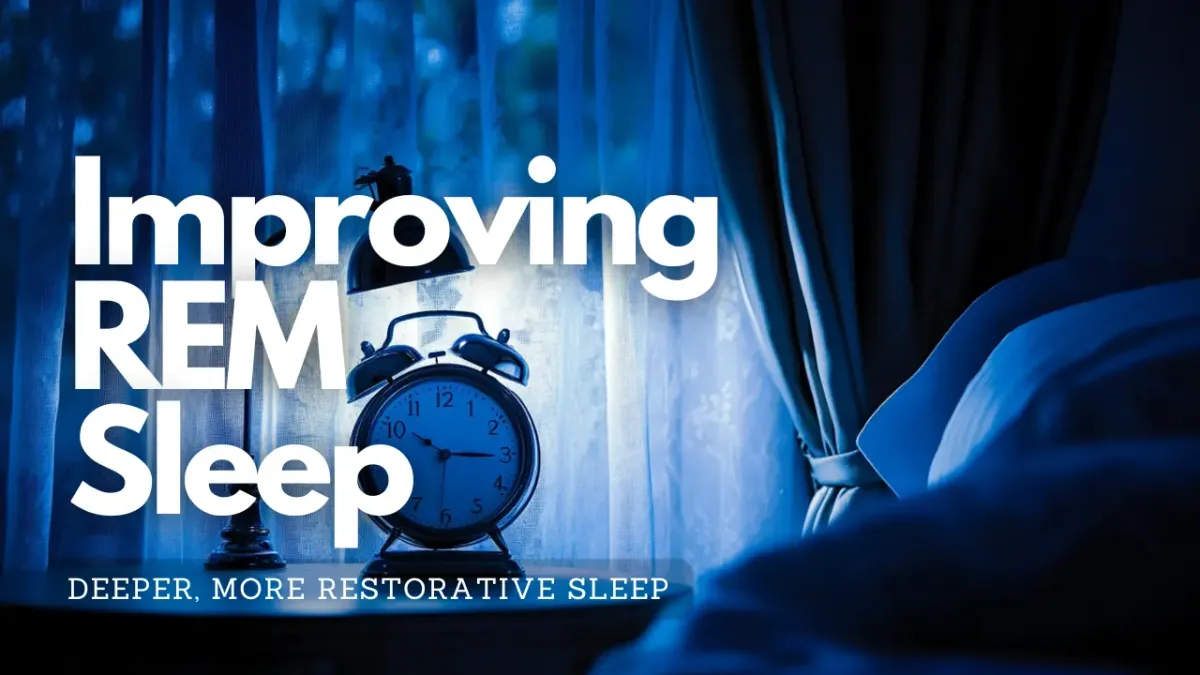13 Methods I Use to Improve REM Sleep
Achieve deeper, more restorative REM sleep with these 13 science-backed methods that transformed my nights from restless to rejuvenating.

I've spent years fine-tuning my sleep habits through trial and error, discovering that quality REM sleep isn't merely about lying down and hoping for the best. As someone who once struggled with restless nights and groggy mornings, I've developed a systematic approach that's transformed my sleep quality from frustrating to fantastic.
While many people focus solely on the number of hours they spend in bed, I've learned that the secret lies in optimizing specific aspects of both day and night routines. The methods I use have not just improved my REM sleep but have changed my entire well-being—and I'm ready to share exactly how I did it.
Key REM Advice
- Maintain a consistent sleep schedule with 7-9 hours nightly, enabling 4-6 complete REM cycles and improved sleep quality.
- Create a cool, dark bedroom environment at 65°F and use comfortable bedding to promote deeper REM sleep.
- Practice evening relaxation techniques like deep breathing, meditation, or yoga nidra one hour before bedtime.
- Eliminate caffeine intake at least 8.8 hours before bed and opt for sleep-friendly alternatives like chamomile tea.
- Exercise in the morning to regulate circadian rhythms and trigger earlier melatonin release for better REM sleep.
Set a Regular Sleep Schedule

Setting up and sticking to a consistent sleep schedule stands as one of the most powerful ways to improve your REM sleep. I've found that going to bed and waking up at the same time every day helps regulate my body's natural sleep rhythm, which directly impacts the quality of my REM sleep cycles.
I make it a point to maintain this schedule even on weekends and throughout vacations as I know that REM sleep occurs primarily in the second half of my sleep period. Each of my sleep cycles lasts between 80 to 100 minutes, with REM episodes getting longer as the night progresses. By keeping consistent sleep times, I guarantee my body completes all necessary REM cycles. Getting the recommended 7-9 hours of sleep each night ensures I experience the full 4-6 REM episodes needed for optimal brain function.
I've noticed significant improvements in my memory and problem-solving abilities following the implementation of this regular schedule. Since REM sleep is crucial for emotional processing, I've experienced better mental well-being with this routine.
To make it work, I set a specific bedtime and wake time, avoid late afternoon naps, and maintain a consistent bedtime routine. I've learned that this consistency is essential as irregular sleep patterns can disrupt REM timing and reduce overall sleep quality, affecting both my cognitive function and emotional processing.
Block Blue Light at Night

I've found that blue-light blocking glasses are one of the most effective tools for protecting your natural sleep cycle, as they prevent artificial light from disrupting your melatonin production in the evening hours.
Research shows that wearing these glasses 2-3 hours before bedtime provides optimal benefits for sleep improvement.
Most digital devices now include built-in blue light filter settings that you can activate in the evening, which I recommend using alongside your blue-light blocking glasses for maximum protection of your sleep quality. Studies suggest that red or orange lamps are also excellent alternatives for evening lighting to minimize blue light exposure.
Blue-Light Blocking Glasses Work
Blue-light blocking glasses step up as a scientifically-backed solution for better sleep by filtering out wavelengths below 530 nanometers - the type of light that interferes most with our natural sleep patterns.
I've found they work by blocking the blue light that would otherwise activate special cells in our retinas, which helps maintain my body's natural melatonin production. Clinical trials support this with evidence from 16 randomized controlled studies involving 453 patients.
I've learned through research that these glasses can increase melatonin levels by 58% after just two weeks of use. When I wear them in the evening, they mimic the effect of a natural sunset, signaling to my brain that it's time to wind down. Quality blue-blocking glasses must cover eyes completely to effectively filter harmful wavelengths.
I make sure to choose glasses that block blue light from all angles, as this provides the most effective results.
Research supports my use of these glasses, with multiple studies showing they reduce the time it takes to fall asleep.
I've discovered they're especially helpful when I need to use screens in the evening. I wear them consistently two to three hours before bedtime, and I've noticed they work better than blue light filtering apps on my devices.
Digital Device Night Limits
Through extensive research into sleep quality, establishing strict digital device limits has emerged as one of the most effective ways to improve REM sleep.
Over ninety percent of adults use their devices within an hour of going to bed.
I've found that setting a digital curfew at least one hour before my bedtime considerably improves my sleep quality. I make sure to turn off all screens, including my phone, television, and computer, giving my brain time to wind down naturally.
Research shows that blue light exposure can significantly disrupt our natural sleep-wake cycles.
When I do use devices in the evening, I adjust their settings to night mode and reduce screen brightness.
I've also learned to avoid stimulating content before bed. Instead of scrolling through social media or checking work emails, which can trigger anxiety and keep my mind active, I choose reading a printed book.
These changes have dramatically improved my sleep quality by allowing my body's natural melatonin production to function properly.
Evening Light Filter Settings
Most digital devices now offer built-in settings to reduce harmful blue light exposure during evening hours.
OLED screens provide better blue light reduction since they can adjust individual pixels, making them more effective at night.
For maximum protection, I wear blue light blocking glasses from sunset until bedtime. Research shows that wearing these glasses after dark can lead to faster sleep onset.
I've learned that clear or yellow-tinted lenses aren't sufficient - you need glasses that block 100% of blue and green light wavelengths up to 550nm to prevent melatonin suppression.
I don't rely solely on these filters, though, as research on their effectiveness isn't conclusive.
I combine these tools with other sleep hygiene practices.
I've set my filters to activate automatically at sunset and deactivate at sunrise.
Most significantly, I still limit my overall screen time before bed, as reducing exposure altogether is more beneficial than depending exclusively on filters.
These approaches work together to support my body's natural sleep-wake cycle.
Create Your Sleep Sanctuary

Creating the perfect sleep sanctuary requires attention to several key elements that work together to promote restful REM sleep. I've discovered that controlling light, temperature, and organization makes a significant difference in my sleep quality.
| Element | My Implementation |
|---|---|
| Lighting | I use blackout curtains and dimmer switches to control light exposure, especially before bedtime |
| Temperature | I maintain my bedroom at 65°F and use breathable cotton bedding |
| Organization | I keep surfaces clear and employ storage bins to minimize visual clutter |
| Atmosphere | I've removed electronics and use a lavender diffuser for relaxation |
I've found that layering my lighting with ambient and task options helps me shift to bedtime more effectively. I'm especially careful about temperature control, using a combination of lightweight throws and cooling sheets to maintain comfort during the night. To minimize distractions, I've implemented a strict no-electronics policy and rely on a white noise machine to mask outside sounds.
My organization system includes dedicated storage solutions that keep everything in its place, creating a calm environment that supports better REM sleep patterns.
Exercise Earlier in the Day

I've discovered that scheduling my exercise routine earlier in the day considerably improves my REM sleep quality. When I exercise in the morning, my body's circadian rhythm aligns better with my sleep-wake cycle, making it easier for me to fall asleep at night.
I've noticed that morning workouts, especially aerobic exercises, trigger earlier melatonin release and help me maintain a consistent sleep schedule.
I make sure to get outside throughout my morning exercise whenever possible, as the combination of physical activity and natural sunlight helps stabilize my body's internal clock.
I've found that this approach has notably decreased the time I spend in light sleep while increasing my deep, slow-wave sleep phases. When I exercise later in the day, I often struggle to wind down due to raised endorphin levels and body temperature.
To maximize these benefits, I incorporate both aerobic activities and resistance training in my morning routine, followed by gentle stretching.
I've learned that maintaining this schedule not only enhances my sleep quality but also helps reduce any symptoms of insomnia I occasionally experience.
Practice Evening Relaxation Techniques

Four essential relaxation techniques have transformed my evening routine and greatly improved my REM sleep quality.
When I'm feeling especially tense, I use progressive muscle relaxation, starting at my feet and working up to my head.
I'll tense each muscle group as I inhale and release it as I exhale, which helps melt away the physical stress I've accumulated throughout the day.
I've also incorporated visualization into my routine, creating a peaceful mental scene that includes all my senses.
When I need extra guidance, I'll practice yoga nidra, lying flat on my back while following a guided meditation.
This form of non-sleep deep rest has been particularly effective in helping me shift from my busy day to a state of deep relaxation.
I've noticed that consistently using these techniques has greatly reduced my anxiety and improved my ability to achieve quality REM sleep.
Cut Off Caffeine Early

I've found that drinking coffee in the afternoon can considerably disrupt my sleep quality, reducing total sleep time by 45 minutes and making it harder to fall asleep at night.
Research shows caffeine should be cut off at least 8.8 hours before bedtime, which means I need to change to herbal tea after lunch to protect my sleep.
When I'm craving a warm afternoon drink, I now select caffeine-free options as much as possible. Drinking things like chamomile or peppermint tea, which don't interfere with my natural sleep cycle.
Afternoon Coffee Disrupts Sleep

The science is clear: afternoon caffeine can wreck your sleep quality even when consumed hours before bedtime. I've learned that drinking coffee in the afternoon blocks adenosine, a chemical that helps me feel sleepy, and this disruption can reduce my total sleep time by 45 minutes or more.
Even when I consume caffeine six hours before bed, I'm likely to spend more time trying to fall asleep and experience more wake-ups throughout the night.
| Caffeine Source | Cut-off Time | Sleep Impact |
|---|---|---|
| Regular Coffee | 8.8 hrs before bed | -41 min sleep |
| Pre-workout | 13.2 hrs before bed | -45 min sleep |
| Small amounts | 8 hrs before bed | -9 min to fall asleep |
I've made it a rule to stop all caffeine intake by 2 PM. This gives my body enough time to clear the caffeine before bedtime. When I followed this guideline, I noticed significant improvements in my sleep quality, especially in achieving deeper sleep stages.
If you're struggling with sleep, I recommend tracking your caffeine intake and gradually moving your last cup earlier in the day to protect your sleep quality.
Switch To Herbal Tea

While cutting back on afternoon coffee helps, switching to herbal teas offers a perfect alternative that can actually improve your sleep.
I make sure to drink my herbal tea about 2-3 hours before I plan to sleep, and I keep the temperature mild to avoid disrupting my sleep later with bathroom visits.
I'm especially careful with my selection of teas, as some varieties require extra caution. For instance, I avoid valerian root tea unless I've consulted with my doctor, and I'm mindful of potential interactions with any medications I'm taking.
My favorite choice is chamomile tea, which contains apigenin, an antioxidant that helps relax my nerves.
I've noticed that making herbal tea part of my consistent bedtime routine has markedly improved my sleep quality over time. It's become a reliable tool in my sleep improvement strategy.
Maintain Optimal Bedroom Temperature

Maintaining an ideal bedroom temperature between 65-68°F (18.3-20°C) plays an essential role in achieving quality REM sleep. I've learned that my body naturally lowers its temperature as I prepare for sleep, and keeping my room within this range helps support this process.
I make sure to adjust my thermostat before bedtime and use appropriate bedding to maintain this ideal temperature throughout the night.
I've found that seasonal changes require different approaches to temperature control. In winter, I keep my bedroom between 60.8-64.4°F (16-18°C), while in summer, I aim for 64.4-68°F (18-20°C).
I use my air conditioning or heating system as needed, and I've installed a small fan for better air circulation. When necessary, I'll open windows to maintain proper ventilation.
If I feel too warm or cold, I'll adjust my bedding rather than dramatically changing the room temperature.
Use White Noise

Beyond maintaining ideal room temperature, adding white noise to my sleep environment has greatly enhanced my REM sleep quality. I've found that white noise effectively masks disruptive sounds and creates a consistent audio backdrop that helps maintain my sleep during the night. By using a white noise machine, I've noticed fewer interruptions from sudden noises like traffic or neighbor activity.
| Type of Sound | How I Use It | Benefits I've Noticed |
|---|---|---|
| Pure White Noise | Bedroom Machine | Blocks sudden noises |
| Pink Noise | Smartphone App | Deeper sleep cycles |
| Nature Sounds | Portable Speaker | Easier to fall asleep |
I've experimented with different volumes and types of white noise to find what works best for me. I typically set my white noise machine at a moderate volume that's just loud enough to mask background disturbances but not so loud that it becomes distracting.
Studies support my experience, showing that white noise can reduce sleep latency and minimize nighttime awakenings. I've made white noise a consistent part of my sleep routine, and it's become a reliable signal to my brain that it's time to rest.
Try Sleep-Inducing Essential Oils

In addition to white noise, I've incorporated essential oils into my sleep routine with remarkable results. I primarily use lavender and chamomile oils, which I've found especially effective for promoting deeper sleep. I apply these oils using a diffuser in my bedroom about 30 minutes before bedtime, allowing the calming scents to fill the air.
When selecting essential oils, I make certain to choose pure, therapeutic-grade products to guarantee safety and effectiveness. I always recommend performing a patch test before trying any new essential oil, as skin reactions can occur.
If you're new to essential oils, start with single oils rather than blends. I've learned through experience that it's important to consult with a healthcare provider before starting any aromatherapy routine, especially if you're taking medications or have underlying health conditions.
Invest in Quality Bedding

I've found that investing in high-thread-count cotton sheets and a memory foam mattress can dramatically improve your REM sleep quality via better temperature regulation and pressure point relief.
Quality cotton sheets help maintain ideal sleeping temperatures by wicking away moisture while allowing your skin to breathe during the night.
The supportive nature of memory foam reduces tossing and turning by conforming to your body's shape, which helps you stay in deeper sleep cycles longer.
High-Thread Cotton Sheets
When choosing bedding for better REM sleep, high-quality cotton sheets play an essential role in your comfort and sleep quality. I've learned that thread count isn't always the most reliable indicator of quality.
I now focus on sheets with thread counts between 300 and 500+, which typically use single-ply yarns for superior comfort and durability.
I prefer Egyptian or Pima cotton sheets as they're naturally breathable and get softer with each wash. In my experience, these materials help regulate temperature during the night, which is vital for maintaining uninterrupted REM sleep.
I've found that sateen weaves offer a luxurious feel, while percale provides a crisper, cooler sensation.
I maintain my sheets' quality by following the care instructions carefully. I avoid using harsh detergents and high heat settings, which can damage the fibers. I wash them regularly in cool or warm water and dry them on medium heat.
This careful maintenance has helped my high-quality cotton sheets last for years while retaining their softness and comfort. The investment in proper cotton sheets has greatly improved my sleep quality.
Memory Foam Mattress Benefits
Beyond quality sheets, a memory foam mattress stands as the foundation of restful REM sleep.
I've found that the mattress's unique ability to contour to my body using heat and pressure creates an ideal sleeping surface that reduces pressure points on my hips, shoulders, and neck. This customized support has greatly improved my sleep quality by relieving joint pain and providing consistent back support.
I especially appreciate how my memory foam mattress supports proper spinal alignment by conforming to my body's natural curves. It prevents me from sinking too deeply while distributing my weight evenly, which has helped reduce my chronic back pain over time.
When my partner moves throughout the night, I'm no longer disturbed thanks to the mattress's excellent motion isolation properties.
The durability of my memory foam mattress makes it a worthwhile investment. I don't need to flip it regularly, and simple vacuuming keeps it clean.
Its dense structure naturally resists dust mites and allergens, which helps maintain a healthy sleeping environment. With warranties typically lasting 10-25 years, I'm confident in its long-term value for improving my REM sleep.
Meditation Before Sleep

Through consistent practice of meditation before bedtime, you can greatly enhance your REM sleep quality and overall rest. I've found that meditation helps me fall asleep twice as fast while increasing my natural melatonin levels. When I meditate, I focus on deep breathing exercises and body awareness, which initiates a relaxation response that counteracts stress.
| Meditation Type | Main Focus | Key Benefit |
|---|---|---|
| Guided | Audio instruction | Structured relaxation |
| Mindfulness | Present moment | Reduces anxiety |
| Body Scan | Physical sensations | Releases tension |
I typically start with a 10-minute session, directing my attention to my breath while letting go of distracting thoughts. This practice has considerably reduced my cortisol levels and increased alpha brain waves, helping me achieve deeper sleep states.
I've noticed that regular meditation not just improves my sleep quality but also enhances my overall mental well-being. The physiological effects are remarkable - my mind becomes calmer, my emotional reactivity decreases, and I experience fewer racing thoughts when trying to fall asleep.
For ideal results, I maintain a consistent meditation schedule and create a quiet, comfortable environment.
Establish a Bedtime Ritual

Building upon the calming effects of meditation, establishing a consistent bedtime ritual can greatly boost your REM sleep quality.
I've found that starting my routine about an hour before I plan to sleep gives my body clear signals that it's time to wind down. I stick to the same bedtime and wake-up schedule every day, even on weekends, which has helped train my brain's sleep-wake cycle.
Then, I'll take a warm shower, which I've discovered helps lower my body temperature and makes me feel sleepy. After that, I brew a cup of chamomile tea and do some light stretching exercises while it cools.
I've made sure my bedroom is set up for ideal sleep by keeping it cool (around 66 degrees), dark with blackout curtains, and free from clutter.
I've also installed a small aromatherapy diffuser with lavender oil, which creates a peaceful atmosphere that helps me shift into sleep mode.
Monitor Your Sleep Patterns

A systematic approach to monitoring sleep patterns has transformed my understanding of REM sleep quality. I use advanced tracking devices to record my sleep duration, timing, and various sleep phases, which helps me maintain a consistent sleep-wake cycle.
I've found that monitoring my sleep cycles, which typically repeat every 90-110 minutes, allows me to enhance my wake-up times and reduce morning grogginess.
I track essential metrics like my heart rate, respiratory rate, and blood oxygen levels throughout sleep. These measurements help me identify potential disruptions and make necessary adjustments.
I've set up my tracking system to alert me of significant changes in these metrics, which could indicate underlying health issues that affect my REM sleep.
I also monitor environmental factors in my bedroom, including temperature and light levels, and record lifestyle choices like caffeine intake and meal times.
By integrating this data with my physical activity levels and stress indicators, I've created an extensive overview of my sleep quality.
This detailed tracking has allowed me to make informed adjustments to my sleep routine, resulting in more consistent and restorative REM sleep cycles.





